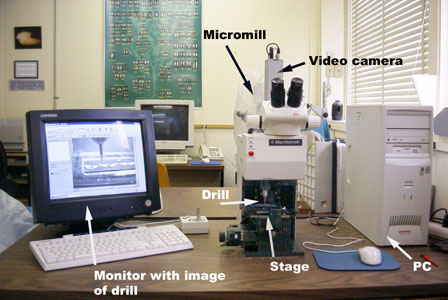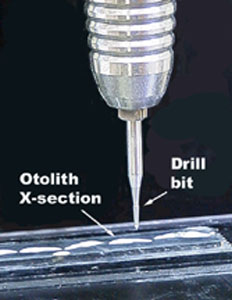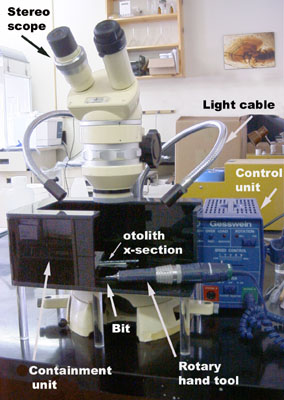Microsampling Techniques
Microsampling techniques are utilized to mechanically extract a portion of the otolith for subsequent analysis. Portions can be extracted as either powders, milled from discrete depths (e.g. annual growth zones) or as cores (e.g. first year of growth).
Assays for bomb radiocarbon and stable isotope ratios are examples of applications where a particular age or date range in the otolith is required. For these applications the best sampling procedures involve microsampling or coring techniques which physically remove a discrete portion of the otolith.
1) Microsampling Device (automated):
We have prepared a 15-minute VIDEO DEMONSTRATION of the use of the Micromill for isolating otolith material, which provides an easy and complete introduction to the process. The information below also describes micromilling, but provides more detail on some of the materials and suppliers than does the video.
A photograph of our Micromill microsampling device is depicted below. This system includes the following:
- Pentium-based PC installed with MicroMill software, Coreco Bandit video board and drivers.
- 17" monitor, maximum resolution of 1280x1024.
- MicroMill sampler (New Wave Research) consists of a Leica stereo microscope fitted with a high resolution colour video camera, fine resolution (0.25 micron) motorized XYZ stages, high torque milling chuck with adjustable speed and carbide tipped or hardened cobalt steel milling bits.
Using on screen digitization of the sample area and precise depth control this system permits automated and accurate microsampling.
In our usual mode of operation the drill bit is used to carve out areas of the otolith, leaving discrete chunks which can be decontaminated prior to analysis.
2) Hand-held Drill:
A photograph of our hand-held sampling setup is depicted to the right. This system includes the following:
- Gesswein Power Hand 2X controller and rotary tool (Z-55X) with maximum speed of 55,000 r.p.m.
- a selection of drilling bits including diamond-tipped orb and circular cutting tools
- Wild stereo microscope
- High-intensity fiber optic illuminator (Nikon) with dual gooseneck cables
- Acrylic containment device, to prevent loss of sample
- HEPA filter vacuuming unit to remove fine dust from the work area
Using a combination of drilling and sculpturing techniques this hand-held setup offers an affordable alternative to the automated MicroMill system. Although accessible, this system is labour intensive to operate and its affordability is outweighed by its lack of precision.
Examples of papers where various microsampling procedures were used include Campana (1997), Campana and Jones (1998) and Schwarcz et al (1998).


